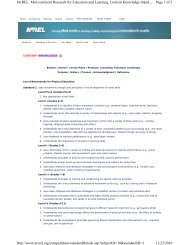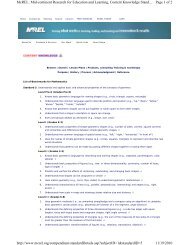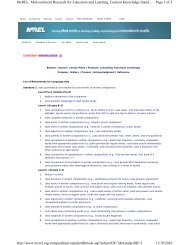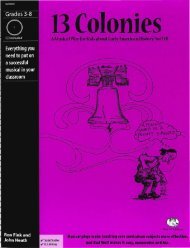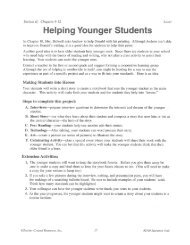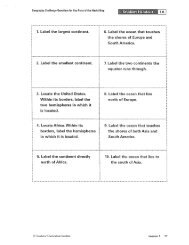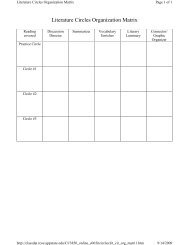McREL Standard 08 Physical
McREL Standard 08 Physical
McREL Standard 08 Physical
- No tags were found...
You also want an ePaper? Increase the reach of your titles
YUMPU automatically turns print PDFs into web optimized ePapers that Google loves.
<strong>McREL</strong>: Mid-continent Research for Education and Learning, Content Knowledge Stand...http://www.mcrel.org/compendium/standardDetails.asp?subjectID=2&standardID=8Page 2 of 311/22/20107. Knows methods used to separate mixtures into their component parts (boiling, filtering, chromatography,screening) A8. Knows that substances react chemically in characteristic ways with other substances to form newsubstances (compounds) with different characteristic properties A9. Knows factors that influence reaction rates (e.g., types of substances involved, temperature, concentrationof reactant molecules, amount of contact between reactant molecules) A10. Knows that oxidation is the loss of electrons, and commonly involves the combining of oxygen with anothersubstance (e.g., the processes of burning and rusting) ALevel IV (Grades 9-12)1. Knows the structure of an atom (e.g., negative electrons occupy most of the space in the atom; neutronsand positive protons make up the nucleus of the atom; protons and neutrons are almost two thousandtimes heavier than an electron; the electric force between the nucleus and electrons holds the atomtogether) A2. Understands how elements are arranged in the periodic table, and how this arrangement shows repeatingpatterns among elements with similar properties (e.g., numbers of protons, neutrons, and electrons;relation between atomic number and atomic mass)3. Knows how the electron configuration of atoms governs the chemical properties of an element as atomsinteract with one another by transferring or sharing the outermost electrons4. Knows that atoms may be bonded together into molecules or crystalline solids, and compounds are formedfrom chemical bonds between two or more different kinds of atoms A5. Knows that the physical properties of a compound are determined by its molecular structure (e.g.,constituent atoms, distances and angles between them) and the interactions among these molecules6. Knows that the number of electrons in an atom determines whether the atom is electrically neutral or anion (i.e., electrically neutral atoms contain equal numbers of protons and electrons; a positively chargedatom has lost one or more electrons; a negatively charged atom has gained one or more electrons) A7. Knows that most elements have two or more isotopes (i.e., atoms that differ in the number of neutrons inthe nucleus); although the number of neutrons has little effect on how the atom interacts with others, itdoes affect the mass and stability of the nucleus8. Knows how radioactive isotopes can be used to estimate the age of materials that contain them becauseradioactive isotopes undergo spontaneous nuclear reactions and emit particles and/or wavelike radiation;the decay of any one nucleus cannot be predicted, but a large group of identical nuclei decay at apredictable rate, which can be used to estimate the material’s age A9. Knows that neutrons and protons are made up of even smaller constituents10. Understands that chemical reactions either release or consume energy (i.e., some changes of atomic ormolecular configuration require an input of energy; others release energy) A11. Knows that chemical reactions can take place at vastly different rates (e.g., from the few femtosecondsrequired for an atom to move a fraction of a chemical bond distance to geologic times scales of billions ofyears) and reaction rates depend on a variety of factors that influence the frequency of collision of reactantmolecules (e.g., shape and surface area of the reacting species, temperature, pressure, the presence orabsence of a catalyst)12. Knows that chemical reactions can be accelerated by catalysts (e.g., metallic surfaces, enzymes)13. Understands the complete mole concept and ways in which it can be used (e.g., actual mass vs. relativemass; relationship between the mole and the volume of a mole of molecules; relevance of molar volumeand Avogadro’s hypothesis) A14. Knows the variety of structures that may be formed from the bonding of carbon atoms (e.g., syntheticpolymers, oils, the large molecules essential to life) and their roles in various chemical reactions, includingthose required for life processes15. Knows that a large number of important reactions involve the transfer of either electrons(oxidation/reduction reactions) or hydrogen ions (acid/base reactions) between reacting ions, molecules, oratoms A16. Understands radical reactions and their role in natural and human processes (e.g., ozone and green housegases in the atmosphere; burning and processing of fossil fuels; formation of polymers; explosions) A17. Understands the properties of solutions and mixtures (e.g., saturation, concentration, solubility) ALevel V (College Readiness)1. Understands how the model of atomic structure has changed over time



